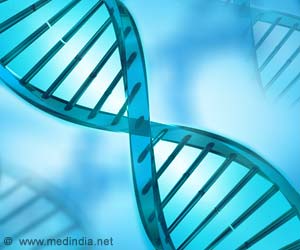An enzyme best known for its fundamental role in building proteins also works as protector of DNA during times of cellular stress, find scientists.

"We overexpressed TyrRS in zebrafish and found that they were totally protected from DNA damage induced by ultraviolet radiation," said TSRI Professor Xiang-Lei Yang, who led the research.
The new finding also could lead to a better understanding of the neurodegenerative disorder known as Charcot-Marie-Tooth disease, some cases of which arise from mutations in the TyrRS gene.
The discovery, resulting from a collaboration among several TSRI laboratories, is reported online on October 2 in the journal Molecular Cell.
Many Roles
TyrRS (Tyrosyl tRNA synthetase) belongs to a family of evolutionarily ancient enzymes that are essential for the cellular assembly of proteins. They recognize the codes contained in gene transcripts and link them to the corresponding amino-acids—proteins' building blocks.
Advertisement
In a study reported in 2012, Yang and her colleagues found that TyrRS appears to have yet another role in the cell nucleus and may relocate there at certain times when protein-making operations slow down.
Advertisement
A Team Effort
For the new study, Yang worked with several collaborating laboratories at TSRI. "The breadth of expertise and the collegial environment here make that easy," she said.
The team, including first author Research Associate Na Wei from the Yang lab, started by creating different stress conditions in several cell types. The researchers observed that only "oxidative" stress, a common stress caused by an excess of highly reactive oxygen molecules within cells, sent TyrRS into the nucleus.
What does TyrRS do in the nucleus? To learn more, the team recorded how gene expression patterns changed in cells when TyrRS flooded the nucleus. Many of these changes, they noted, were surges in activity among genes that had previously been linked to DNA protection and repair. Excluding TyrRS from the nucleus prevented those surges.
In subsequent experiments, the team was able to tease apart the molecular details of how TyrRS in the cell nucleus takes the molecular brakes off DNA damage response gene expression. They also were able to show in lab dish experiments that TyrRS's move to the cell nucleus provides considerable protection against oxidative DNA damage—markers of such damage were much lower that way.
"We found that TyrRS promotes the most conservative and error-free homologous recombination pathway for DNA repair, which would help maintain the stability of the cell genome whenever it sustains damage," said collaborating TSRI scientist Associate Professor Xiaohua Wu, DNA repair expert.
To confirm the physiological relevance of TyrRS's protective role, the researchers artificially boosted TyrRS's expression in embryonic zebrafish—effectively forcing some TyrRS into cell nuclei where it could perform its gene-activating role. The TyrRS influx turned out to provide strong protection from DNA damage caused by ultraviolet radiation. (Ionizing radiation is one of many triggers of DNA-damaging oxidative stress, although it can damage DNA directly as well.) Again, when the scientists excluded TyrRS from the zebrafish cell nuclei, the protective effect went away.
"This has been a fruitful Scripps-wide collaboration," said TSRI Assistant Professor Shuji Kishi." In fact, second author, Yi ('Eric') Shi came from the Yang lab at Scripps California, and played a key role by quickly mastering/performing all the essential skills for zebrafish in my lab at Scripps Florida. With the zebrafish model system, we were able to demonstrate TyrRS's genome-protecting role at the level of the organism."
"I was quite surprised to see such a clear result," said Yang.
Potential Medical Applications
In principle, she adds, a therapy that somehow brings more TyrRS into cell nuclei, or mimics its activity there, could provide strong DNA protection for people with radiation or toxin exposure, or hereditary DNA repair defects.
Yang hopes too that TyrRS's newly elucidated role in the nucleus will end up clarifying the mechanisms underlying Charcot-Marie-Tooth (CMT) disease, a collection of hereditary peripheral nerve degeneration syndromes that affect at least a few million people worldwide. Some cases of CMT have been linked to mutations in TyrRS's gene, and a 2009 study found that those mutations don't impair TyrRS's main, enzymatic function in protein translation—which suggests TyrRS's role in the nucleus as the next focus of investigation.
"I suspect that TyrRS's nuclear function is relevant to CMT," said Yang. "That hypothesis has been an important motivation for our work and it's something we intend to pursue further."
Source-Eurekalert











